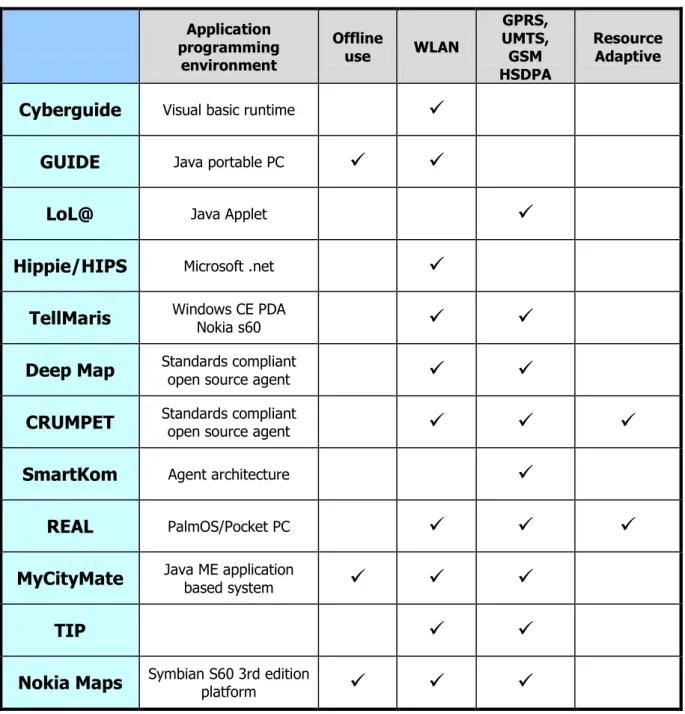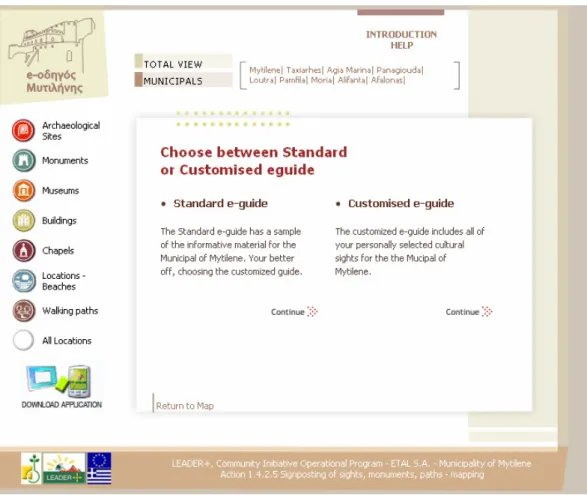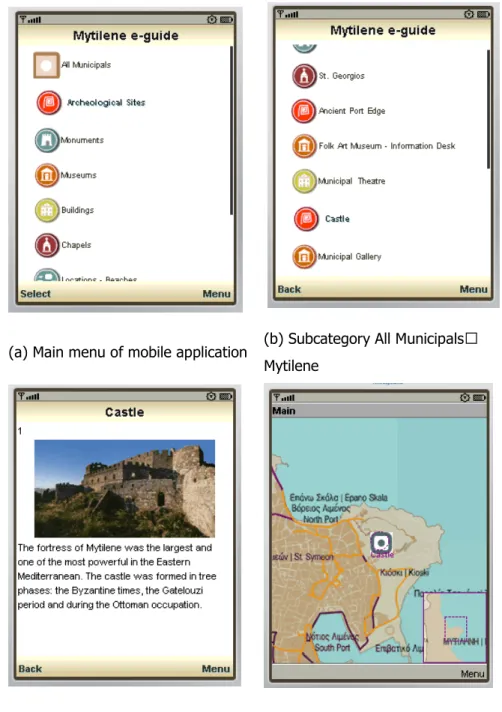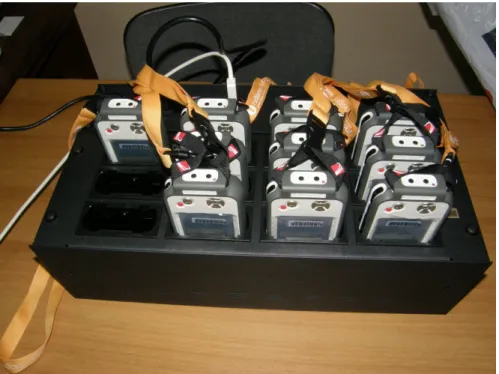Damianos Gavalas, Assistant Professor, Department of Cultural Technology and Communication, University of the Aegean (Advisor) Βαγγελιώ Καβακλή, Assistant Professor, Department of Cultural Technology and Communication, University of the Aegean (Member of the 3-member co-advisory committee). George Tsekouras, Assistant Professor, Department of Cultural Technology and Communication, University of the Aegean (Member of the 3-member co-advisory committee).
INTRODUCTION
The Landscape of Mobile Tourism
This requires innovation and extraordinary progress in the emerging field of mobile software engineering. It is undeniable that mobile devices exhibit many unique features that make their use in the mobile tourism paradigm (namely as mobile tourist guides) particularly attractive: these features are….
Research Questions & Motivation
However, due to the large number of mobile devices available, there are serious questions regarding the transfer of mobile applications to the target market of developers. We argue that existing recommendation systems do not take into account the context of the mobile tourism user, i.e.
![Figure 1-1. Fragmentation of mobile applications (Source: [41])](https://thumb-eu.123doks.com/thumbv2/pdfplayerco/305462.43072/23.892.220.713.108.490/figure-1-1-fragmentation-mobile-applications-source-41.webp)
Overview and Style of Thesis
It explains the significance and contributions of this thesis and also identifies areas where the work presented herein could be further developed.
MOBILE DEVELOPMENT PLATFORMS: DEVELOPING
Introduction
The purpose of this chapter is to provide an overview of the mobile application development environment and to identify a coherent set of requirements that application development platforms should meet in order to enable successful, efficient and economical development of cultural applications on mobile devices. The rest of this chapter is structured as follows: Section 2.2 describes the evolution of the mobile phone in terms of HCI and mobile device characteristics.
Types and Evolution of the Mobile Phone
While most feature phones are capable of running applications based on platforms such as Java ME [163]. Many are equipped with cameras and support for wireless Bluetooth headsets for hands-free communication.
Mobile Application Design Requirements
- Issues related to the design of mobile applications
- Issues related to the design of mobile applications for cultural organizations and
- Java Platform, Micro Edition (Java ME)
- Microsoft .Net platform for the Mobile Web
- Adobe Flash Lite
- Android Platform
The .NET Compact Framework (.NET CF) [115] is a subset of the overall .NET platform designed by Microsoft for Windows Mobile applications. Core components are a subset of the entire .NET Framework and provide about ~30% of the classes and functionality.
![Figure 2-2. Java technologies and their respective target devices (adapted from [184])](https://thumb-eu.123doks.com/thumbv2/pdfplayerco/305462.43072/40.892.131.755.106.503/figure-java-technologies-respective-target-devices-adapted-184.webp)
Comparison of Application Development Platforms: Software Architecture,
On the other hand, .NET CF targets a limited set of Windows end devices and lacks free development tools (Visual Studio ships with a license fee). Support for well-known formats (wav, mp3, etc.) offered by third parties (eg Resco Audio for .NET CF).
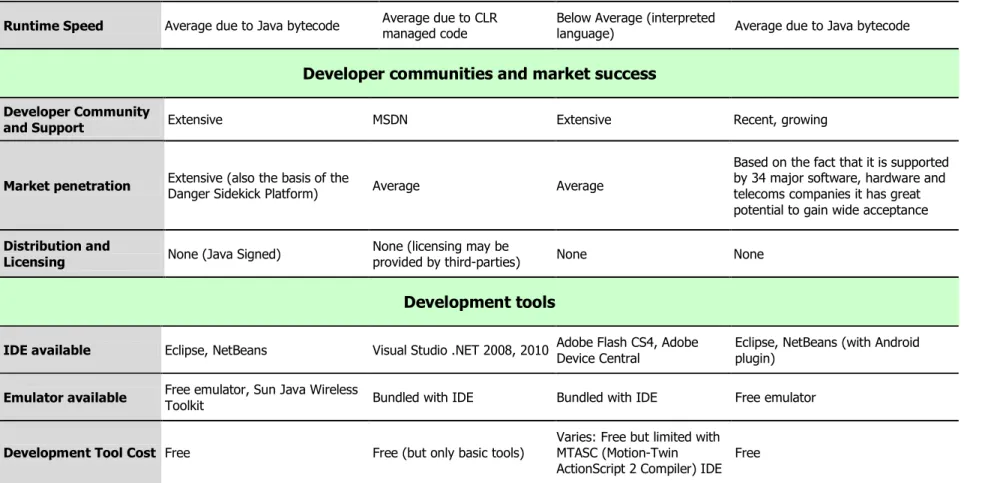
Current Trends
Java ME's competitiveness against platforms targeted at graphics-heavy applications (eg, Flash Lite) will also depend heavily on the delivery of technologies that will enable the production of expressive, feature-rich content for mobile devices. Moreover, comparative studies show that Flash Lite exhibits lower performance and frame rate while being more memory intensive than Java ME [163].
Requirements for Cultural Application Development Platforms
Taking advantage of the opportunity to run a large number of existing Java ME applications can also add value to Android. In this line, download services are available to convert existing Java ME titles to the Android platform (eg Tira Wireless and J2ME Polish).
Selection of Mobile Application Platform
That is, the use of thin client technology (i.e. web browsers) used to service web users and the use of custom thick clients (i.e. mobile Java application ported to various mobile phones) to service mobile device users. This is because client side technology (e.g. Jacascript) cannot be fully supported by mini web browsers [28] and therefore Google has developed a standalone application to be installed on the mobile device side, mostly using Java ME.

Conclusions
THE LANDSCAPE OF MOBILE TOURIST GUIDE PROJECTS
Introduction
Design Criteria
Did the projects provide different types of information using multimodality technologies such as 3D graphics or speech. Have the projects integrated any existing standards-based frameworks or initiatives to support tourist users or are all services appropriate.
The Evaluation
- Information Models
- Position and Map technologies
- Architecture/ Network Infrastructure
- Input/Output Modalities
- Unique Services
The network technology used reflected the projects' available infrastructure and the availability of such network infrastructure. The MyCitymate and Mytilene guide systems included a mobile application developed on top of the Java ME platform [163], which essentially includes a certified collection of Java APIs for developing software.
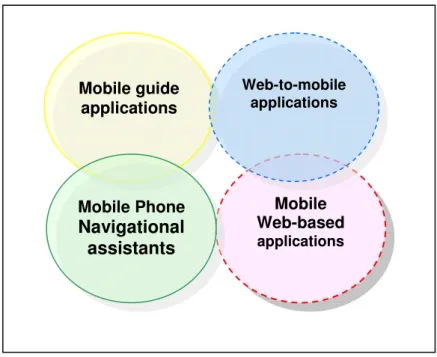
Evaluation Results
Finally, regarding the services offered to tourists, it was observed that these were divided into three different phases of the tourism life cycle: the pre-visit phase, the visit phase and the post-visit phase. The post-visit phase emphasized the need to document the visit by offering it to tourists as a means of recording their visit to be retrieved online at a later stage.
Design Principles vs. Current Trends
Using a personal profiling system means that the information model must be dynamically generated with respect to the user's explicit profile and implicit usage history. Moreover, an application designer must design a mobile tourist guide system taking into account internationalization (multilingualism); the case where more languages can easily be brought to the tourist guide should be integrated into the original system design.
AN INNOVATIVE MOBILE ELECTRONIC TOURIST GUIDE
Introduction
Our in-depth research in Chapter 3 shows that tourists who have access to a mobile tourist guide with personalized content, without the need for a constant connection, are more likely to use the mobile device in some way while at the destination are. The optional use of a network connection enhances the mobile tourist guide application by providing personalized content and social application services. For example, the use of personal profiles to classify users into groups (by applying algorithmic clustering solutions) with the intention of sharing multimedia content among users with similar interests.
Designing the Multiplatform Tourist Guide Framework
If the user creates an account, they will have access to their own personal profile pages upon return and login. The user can also use the recommendation system linked to his personal profile with the aim of adding new content to the 'shopping cart' selection.
The Development of a Multi-Platform Tourist Guide Framework
- The Tourist Web Application
- The Mobile Application
- The PDA Application
When the user 'checks out', the contents of the suitcase are converted into XML format, with the web system automatically activating the mobile application builder and porting mechanism, which generates the mobile application (runnable on the user's mobile phone) containing the selected XML-based tourism content. For users with limited storage space on mobile devices, there is an option on the application customization pages (i.e. the 4-step process described in Section 4.3) to include map files and/or media files.
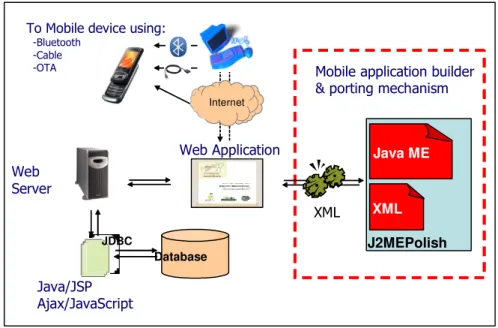
The Evaluation
The platform has been found to be efficient with regard to the OTA installation and also the task involving the usage scenarios of the mobile directory. The overall web and mobile platform was found to be highly understandable, but many participants found using the platform, including the mobile app, to be moderately useful.

Conclusions
Portions of this chapter were published in the journals Personal and Ubiquitous Computing and Multimedia Tools and Applications.
A PERVASIVE MOBILE TOURISM RECOMMENDATION
Introduction
The e-guide framework only addresses personalization in the context of allowing users to explicitly select tourism content to be included in a custom mobile application that is generated on-the-fly and adapts the application to fit the user's screen size and hardware limitations. mobile phone. Therefore, the mobile guide application extension presented in this chapter allows the user to jointly contribute to uploading and sharing tourism-related information with peers, such as ratings, comments, and multimedia content relevant to specific POIs.
Personalization and Recommendation Techniques in Electronic and Mobile
Some systems also allow the dynamic creation and customization of personalized mobile applications based not only on the selection of personal content, but also on the characteristics of the user's personal device (screen size, ability to handle multimedia content , free memory resources, etc.) [120] . Likewise, content recommendations can depend not only on user interaction history, but also on the user's location and context.
Design and Implementation of the Recommender System
In addition, the user can see the total rating of the content by all users. Therefore, MTRS prioritizes recommendations for POIs located near the user's current location.

Infrastructure and Update Mechanism of Tourist Information Portals from
The user then performs a Bluetooth handshake with the sensor node to establish a connection. At a later time, the sensor node forwards data received from the user's mobile device to the sink (either directly or via several intermediate nodes), and the sink in turn sends the data to the remote server (tourist portal).
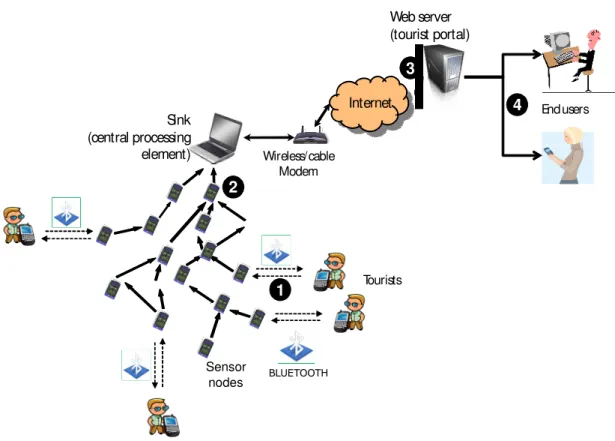
Summary
Introduction
Interestingly, TIDP presents similar problems to those that have arisen in the past in operational research; such problems lie in the mathematical theory of graphs (graph theory) and include variations of the well-known traveling salesman problem (TSP). The main contribution of this chapter lies in the modeling and in the study of a generalization of TOPTW by introducing a new heuristic that provides near-optimal solutions for TIDP: Daily Tourist Itinerary Planning (DailyTRIP).
Related Work
Dailytrip Modelling
The problem definition also includes the 'earning' of a POI, calculated as a weighted function of the objective and subjective importance of each POI (subjectivity refers to individual user preferences). The most important constraint in the search for robust algorithmic solutions is the daily time frame T that a tourist wants to spend sightseeing; the total daily route duration (i.e. the sum of visit times plus the total travel time spent moving from one POI to another, which is a function of the topological distance) should be kept under T .
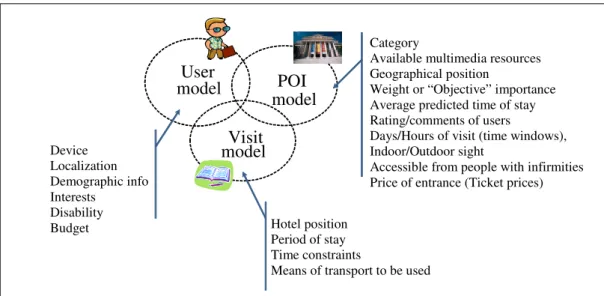
Dailytrip: A Heuristic for Deriving Near-Optimal Personalized Daily Tourist
- Problem Statement
The Dailytrip Algorithm Flow
In particular, for each junction node i which may not be visited during the days Dc(i), the 'excluded' days of the travel plan I. The outcome of the previous phases is in particular not a set of travel routes, but rather ' a set of itinerary trees.

Implementation Details and Evaluation of Dailytrip
- The Java Application
- Process Flow
- Java Back-End Library
- Java Web Application
The Java web application uses the Google Maps API (application programming interface) to display a map of the area of interest. It uses the list of POIs selected by the user on the previous page and creates one.

ILS algorithm
Using this approach, the ILS algorithm does not have to go through a large number of combination and permutation checks (it only considers the links that come from the last inserted node), but it fails to examine any more suitable candidate nodes in a global perspective. As can be seen in Figure 6-10d, however, the path ultimately derived by the ILS generally neglected the 'important' POIs (with high gain values).
Simulation Comparison between DailyTRip and ILS algorithms
Simulation output of the total distance compared to the increasing number of POIs per race for 3 travel routes. Finally, Figure 6-19 shows the variance of the total profit per day (ie the sum of the surplus of POIs visited on each day).
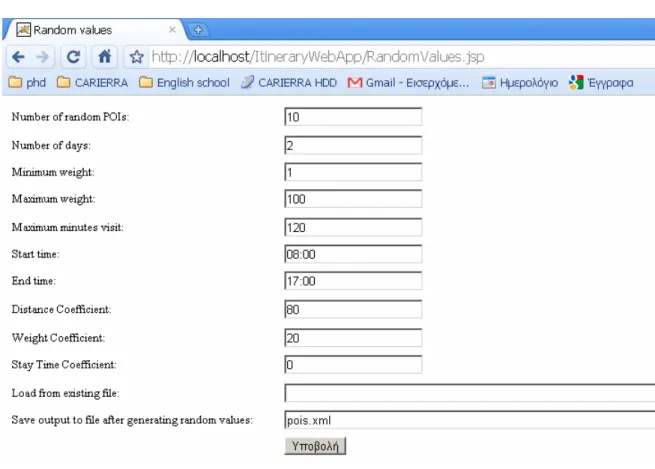
Summary
In particular, the algorithm takes less than 2.5 seconds for topologies of 15 nodes, which is a reasonable number of POIs to visit at any destination to derive a solution (without the time needed to draw the solution in Google Maps) that deviates less as 7% of the optimal solution when considering problem spaces spanning up to 25 nodes. where the profit of the individual is calculated as a function of the 'target' POI. importance and potential user interest in the POI) while not violating the daily viewing time budget. Part of the research presented in this chapter was published in the Proceedings of IEEE ISCC’2010 (see Appendix A).
SUMMARY, RESEARCH CONTRIBUTIONS & DIRECTIONS FOR
Summary of Main Research Contributions
This system uses collaborative filtering techniques while also taking into account contextual information (eg time, season, weather conditions and the user's location at the time she "publishes" information about a POI) to derive improved recommendations in a widespread environment. Implementation and evaluation of DailyTRIP, a heuristic approach for deriving personalized daily tourist itinerary recommendations for tourists visiting any tourist destination.
Directions for Future Work
International Conference Intelligent User Interfaces archive, Proceedings of the 7th International Conference Intelligent User Interfaces. Proceedings of the 5th International Symposium on Human Computer Interaction and Mobile Devices and Services (Mobile HCI’2003): 1-5.
APPENDIX
